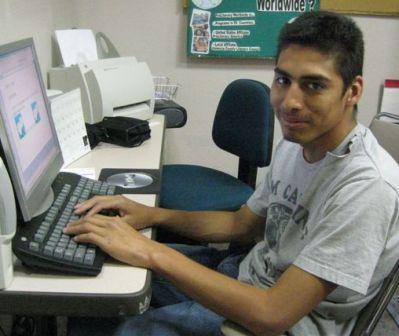Lessons for Living: What is media literacy? What we need to know

Photo Courtesy of the Valencia County Literacy Council | Jeremy, a VCLC student, engaging in online tutoring through the Valencia County Literacy Council.
“It’s a complex world we are living in, so being media literate — if you’re not media literate, you’re not prepared to function as a citizen of this century, you’re not literate.”
Pamela Pereyra has been a media literacy educator for more than 20 years, acting as the New Mexico chairwoman for Media Literacy Now, an nationwide advocacy organization for media literacy, and the founder and director of Media Savvy Citizens.
“Yes, you may be able to read a book, or write a letter or write an email, but we need to do a lot more than read and write,” she said.
The U.S. National Association for Media Literacy Education defines media literacy as “the ability to access, analyze, evaluate, create, and act using all forms of communication.”
Much like literacy itself, media literacy is an umbrella term encompassing all the ways to interact and understand the thousands of mediated messages around us. It can be broken down into different categories, such as news literacy, digital literacy and information literacy, but all have to do with critically looking at the message being sent.
“If you think about media, media is beyond broadcasting, newspapers, radio and TV. We are living in a world that is networked, it is instant,” Pereyra said. “We have social media, we have lots of communications that are mediated, including the language of coding.”
As recently as a couple of decades ago, people consumed media differently. What used to be a top-down model with the message controlled by few has transformed into a web with the integration of the internet into everyday life.
“We are bombarded with images and icons and brands, just all the different ways, memes and 140 characters,” Pereyra said. “So, all of those are messages coming from the media and are mediated. The media is not they, it’s us. It used to be they, top down, but now it’s us.”
Both Media Literacy Now and Media Savvy Citizens focuses on incorporating media literacy education into K-12 schools.
In 2020, Media Savvy Citizens launched a pilot program to integrate media literacy education into the general curriculum through a program titled “Teachers Transform.”
Belen Consolidated Schools was one of 30 different school districts that participated in the pilot program.
Pereyra said teaching students to analyze media messages using skills such as identifying bias and credibility is one of the focuses of the program.
“On YouTube, just because somebody has millions of followers does not make that person credible, it just makes them popular … (and it) does not make them credible on a specific matter, like if you are looking at COVID or you’re looking at any number of issues,” she said.
During the 2022 New Mexico Legislative session, Senate Bill 195 would have expanded media literacy education in public schools, appropriating $400,000 to the cause, however the bill died in committee and never made it to the Senate floor.
After the first rendition of the junior appropriations bill was vetoed by the governor in March, during the last special session, a similar bill was approved, appropriating $50,000 to the New Mexico Public Education Department for an expansion of statewide media literacy program.




